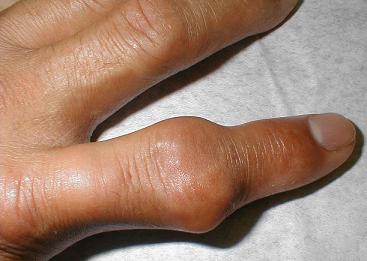

Gout is a type of arthritis, in which crystals of sodium urate produced by the body can form inside joints.
The most common symptom is sudden and severe pain in the joint, along with swelling and redness. The joint of the big toe is usually affected, but it can develop in any joint.
Symptoms can develop rapidly to their worst point in 6-24 hours and usually last for 3-10 days (this is sometimes known as a gout attack). After this time, the joint will start to feel normal again and any pain or discomfort should eventually disappear completely.
Most people with gout will have further attacks in the future.
What causes gout?
Gout is caused by a build-up of uric acid in the blood. Uric acid is a waste product made in the body every day and excreted mainly via the kidneys. It forms when the body breaks down chemicals in the cells known as purines.
If you produce too much uric acid or excrete too little when you urinate, the uric acid builds up and may cause tiny crystals to form in and around joints.
These hard, needle-shaped crystals build up slowly over several years. You will not know this is happening.
The crystals may cause two problems:
-
Some may spill over into the soft lining of the joint (synovium), which causes the pain and inflammation associated with gout.
-
Some pack together to form hard, slowly expanding lumps of crystals (“tophi”) which can cause progressive damage to the joint and nearby bone; this eventually leads to irreversible joint damage which causes pain and stiffness when the joint is being used.
Factors which increase your risk of gout include:
-
age and gender: gout is more common when you get older and is three-to-four times more likely in men
-
being overweight or obese
-
having high blood pressure or diabetes
-
having close relatives with gout (gout often runs in families)
-
having long-term kidney problems that reduce the elimination of uric acid
-
a diet rich in purines; such as frequently eating sardines and liver
-
drinking too much beer or spirits – these types of alcoholic drinks contain relatively high levels of purines
Treating gout
There are two main goals in treating gout:
-
relieving symptoms during an attack of gout: using the non-steroidal anti-inflammatory drugs (NSAIDs) types of painkillers; in some cases alternative medications may also be required
-
preventing future gout attacks: through a combination of lifestyle changes (such as losing weight if you are overweight) and taking a medication called allopurinol to lower levels of uric acid
When medication is taken as directed with recommended lifestyle changes, such as changing your diet and drinking less alcohol, many people reduce their uric acid levels sufficiently over time and dissolve the crystals that cause gout.
Who is affected
Gout is more common in men than in women. This is mainly because the female hormone oestrogen that is released during the female reproductive cycle reduces a woman's levels of uric acid by increasing excretion of uric acid via the kidneys.
After the menopause, uric acid levels rise in women and they too can become liable to getting gout.
However, because the incidence of gout increases with age, it affects 1 in 14 older men and 1 in 35 older women.
Gout symptoms usually occur after the age of 30 in men, and after 60 in women.
Complications
Complications of gout are uncommon but can include:
-
kidney stones – high levels of uric acid can also lead to stones (uric acid and calcium stones) developing inside the kidneys
-
“tophus” formation – tophi are small-to-large firm lumps sometimes visible and easily felt under the skin
-
permanent joint damage – caused by ongoing joint inflammation between the acute attacks, and by formation of tophi within the joint that damage cartilage and bone; this is usually only a risk if gout is left untreated for many years